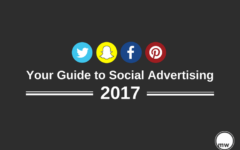Your Guide to Social Advertising in 2017
In the year 2017, Facebook, Twitter, and Instagram are the new ABC, NBC, and CBS. If your brand isn’t advertising on these platforms, you’re missing out on a chance to reach hundreds of millions of consumers.
Sometimes it’s hard to know where to start, as these social networks are constantly evolving their ad capabilities and features. Not to mention, the technology and trends in society seem to be changing quicker than ever before.
Where and how should you spend your social advertising budget in 2017? Let us guide you with these tips!
Facebook is still leading the way
While Snapchat, Pinterest and other platforms are gaining ground, Facebook is still the most effective social advertising tool. We don’t see that changing in 2017. According to an eMarketer survey in 2016, social media marketers overwhelmingly voted Facebook as the platform that produces the greatest ROI.
With multiple ad types to choose from, as well as several placement options, Facebook offers an abundance of ways to reach your target customers. You can extend your Facebook ads to the Instagram platform, which is now a mainstream advertising network with over 600 million users and 500,000 advertisers.
Facebook also allows you to upload customer lists and target them directly. As consumers demand shopping experiences tailored to their specific wants and needs, this is a great way to target an audience directly with specific messaging.
Leverage TV Targeting with Twitter
Despite the massive increase in social media usage, Nielsen data shows that over 95% of U.S. homes still have a television. So how can you reach consumers who browse social media on their mobile devices while they watch TV? Twitter is a great place to start.
Twitter allows advertisers to reach Twitter users engaged with specific programming, specific networks, or specific genres. This type of advertising can be beneficial in a couple ways: First, it allows marketers to create conversational ads with calls to action or customizable hashtags that relate directly to what they’re watching on TV. Second, you can get insightful data about what your target demographics are into.
Snapchat the next Facebook?
With 70% of the 18-24 age group active on Snapchat, there is no doubt as to why this social network is worth billions of dollars. Recently, Snapchat announced the official opening of their ad platform along with six new API partners. According to one source, they’re following closely in Facebook’s footsteps:
“Snapchat is totally copying what Facebook did. They now have all the right tech partners to build the platform for them and bring in revenue,” an anonymous source told AdAge.
This could be the beginning of something big for Snapchat. Keep an eye on their API. If your brand is trying to reach a younger audience, start experimenting with Snapchat. It’s very possible that in five years, it will represent the apex of the social advertising world.
New Pinterest targeting options
Similar to Facebook’s re-targeting options, Pinterest is now allowing its advertisers to retarget users who engage with pins and website content. When people take certain actions on your site, it is now easier to show them Promoted Pins that they may find relevant. These new options represent an enticing way to push personalized content to people that have previously interacted with your brand in some way.
While it lags behind the other social platforms in terms of monthly active users, Pinterest increased its user base by 50% in 2016. The female-dominated social network also sees major spikes in traffic during Q4, making it perfect for B2C brands.
Does your marketing strategy include a budget for social advertising? In 2017 and beyond, you can’t afford to miss out on the opportunity to reach new customers and promote new products and services to the millions of potential customers that hangout on various social networks. Contact mywebwow to discuss a comprehensive social advertising strategy for your brand.



